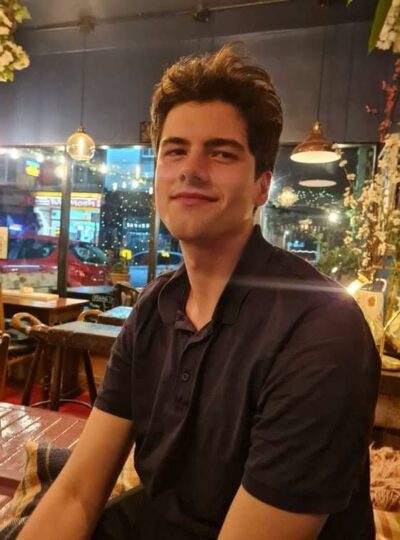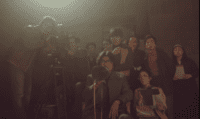Rotoscope is a technique that’s been applied off and on for as long as animation has existed as a medium and nowadays is mostly performed with a computer. What is the motion capture of say, Avatar, but a sophisticated form of rotoscoping, painting over reference footage with the aid of a computer. The animation style used by Polish husband and wife filmmakers Dorota Kobiela and Hugh Welchman uses an altogether more traditional and low-tech version of rotoscope though, with each one of the many thousands of frames making up each of their pictures, hand-painted by a team of artists, giving it the vibrant human touch of oil on canvas, and the uncanny realism of movement and light one gets from a live-action feature. It’s a staggeringly ambitious process and one used to great effect for their debut feature Loving Vincent, which is, quietly a bit of a masterpiece of modern cinema. Unsurprisingly, given the volume of work such a project entails, it has taken the duo six years to produce their follow-up, an even more ambitious project to adapt Wladyslaw Reymont’s four-volume novel The Peasants to screen.
Set in late 19th Century rural Poland, the story follows Jagna (Kamila Urzedowska), a free spirited local beauty who catches the eye of miserly widowed farmer Boryna (Miroslaw Baka) and, independently, of his proud, brutish son Antek (Robert Gulaczyk). Boryna arranges a marriage for himself and despite her misgivings, Jagna resigns herself to her new fate, enraging the violent Antek, who gets himself cast out by Boryna, only for Jagna and he to begin an affair. Are you by any chance already struggling to imagine reasons to care about these people?
As with Loving Vincent, The Peasants is a luminous work of art and an incredible achievement. In an era when craftspersonship is being purposely drained out of the artistic process, Welchman’s projects are no mere vanity concept but a paean to the very craft they are, and an undertaking to be celebrated. However, when it comes to the story told through this endeavor, I can’t help but feel there’s a mismatch of form and content, and a collapse of storytelling at play. On the micro-level, The Peasants is a wondrous feat. On the macro-level, I didn’t care for a single character. The story was trite and cloying when it wasn’t cruel and unpleasant, and what power I could draw from its story of feminine independence, freedom and compassion was reserved for the final minute or so. Elsewhere, The Peasants tells a frustrating melodrama of proud, bitter and angry people whose problems I really found little reason to trouble myself with.
I had a hard time remaining fully on board with the film’s heroine. Yes, Jagna is a prisoner to a patriarchal system and judgmental puritanical community against which she rails at her peril, and at whose hands she suffers terrible injustice. She is a compassionate and creative person who wants only to live in a cottage-core idyll making paper cut-outs, but she’s also just extremely shallow, foolish and one-note. Jagna clearly views herself as above the rest of the community, taunting Antek’s justifiably jealous wife, and she flat-out refuses to help on the farm. She’s never given any real character, agency or personality, just existing to be the perfect victim in the film’s shallow screed on hateful, small minded and jealous peasantry. It’s easy to sympathize with the film’s misanthropy, but there’s nothing special about it. We see a million reasons to hate people every day, and this film’s story doesn’t merit the redemptive beauty of its presentation. Perhaps, as beautiful as they are, the uncanny merits of rotoscoping work to the film’s detriment. It’s both too realist to work in the broad gestural archetypes of the story, and too fabricated for the story to feel intimate and human.
There’s some subtext about the earth and in this farming community in The Peasants, where the main currency is land. Antek compares Jagna to holy soil, a backhanded compliment the other side of which is in context not so much that he thinks of her as dirt, but as a commodity for him to possess and guard jealously. For all the hand-wringing the other farmers do about the land, only Jagna herself displays any genuine love of the natural world. Her first real act is to nurture a wounded stork. Boryna’s first is to slaughter a diseased cow and Antek’s is to refuse to butcher the carcass. His pride would rather let it fester. Not all of the book’s complexity is lost in translation, but it does feel as if the story here would be best seen on the page. The best part of the film is unquestionably the final scene, a cathartic whiplash from brutal degradation to sublime victorious transcendence and freedom, from hell to heaven in the span of one minute.
There is definitely much to praise about The Peasants. I won’t say it’s worth watching just for the animation cause Loving Vincent did the same thing and it worked better there. It was more stylized, less photo-realistic and more fitting for the more dreamlike tone. It would still impress on its own merits but I wouldn’t direct anyone’s attention to The Peasants in preference to that film. Nor can I quite say The Peasants is worth watching just for that ending. There are some effective and poignant dramatic scenes dotted throughout but they might not be quite enough to sustain interest in a frosty and frustrating story whose bleakness the sublime ending cannot quite dispel. I really hope that the efforts of the filmmakers pay off and this film does find its audience, because I do see a future in this approach and would really, really love to see more films explore its qualities in different genres, but unfortunately, an adaptation of this kind is about the least interesting thing I think could have been done with it.



